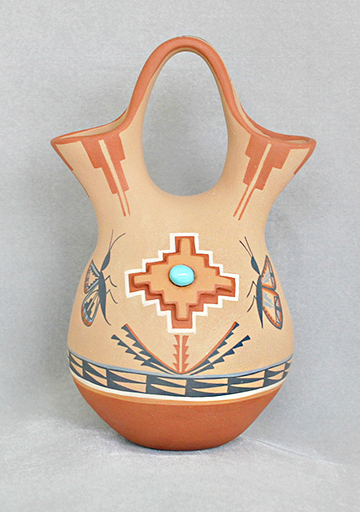
![]() Back to Native American Crafts Information Menu
Back to Native American Crafts Information Menu
Origins
Of all Mother Earth's many gifts, few are more wondrous than clay. Properly cleaned, refined, tempered, cured and fired, clay can be shaped into containers for carrying water, for storing and cooking food, for religious as well as decorative objects. Not only is pottery one of humanity's oldest crafts, but it is also one of our oldest art forms.
In the past, the skill of pottery making was associated with Neolithic culture, with the development of agriculture and settled communities (6000 - 4000 BCE). However, Professor Marek Zvelebil and Lecturer Peter Jordan of the University of Sheffield have shown that pottery was being made by Asian hunter-gatherers 13,000 years ago. They believe knowledge of pottery-making spread from China into Japan and westward across northern Eurasia to Europe.
By 4000 - 3000 BCE, Chinese and Middle Eastern potters were using potter's wheels and closed kilns. By the 7th century BCE Chinese potters of the T'ang dynasty were producing unrivaled glazed earthenware as well as porcelain. Greek potters were exporting their characteristic black figure pottery and in Meso-America the Olmecs were creating unglazed tripod pottery.
Although ceramics making began in Central America around 9000 BCE, the skill did not arrive in North America until 4000 BCE when Indians of the Southeast first took it up. About this same time the dog was domesticated and agriculture and a more sedentary life style became common in this area. Using local clays, they made an unglazed slab and coil pottery fired in open pits and burnished with smooth stones chosen for this purpose. Michael Simpson, author of Making Native American Pottery, comments that when examined, some of the polishing stones of one Catawba potter handed down to her by her grandmothers were found to be mastodon teeth!
By 900 CE most of the indigenous peoples of North American were making pottery. The Mississippian Mound Builders were creating outstanding coiled pottery fired in open pits. Their human and animal effigy pots are considered some of the finest North American Indian pottery of that period.
Ironically, the craft came late to the native peoples best known for their pottery today. Contemporary with the Mound Builders, the Anasazi of the Chaco region were making simpler black on white ceramics decorated with geometric patterns, and elaborated gray cooking pots.
Their neighbors, the Mogollan, were making red on brown ware and three circles red on white bowls. At the same time Mimbres potters were beginning to make their well-known ceramics. Mimbres polychrome pottery, a gray or red clay covered by a heavy white slip with a yellow slip added to create a third color, appeared around 900 CE.
Today, when most people think of Native American pottery, they are thinking of the pottery created by descendants of the Anasazi. After their migration from the Chaco area in north-western New Mexico, they settled in a broad region stretching from the Hopi mesas on the west to the Rio Grande pueblos and Taos Pueblo on the northeast. However, many North American tribes-the Catawba to name just one-have successfully revived their traditional pottery and are producing unique and beautiful ceramics.
How Is Traditional Native American Pottery Made?
When a Native American potter goes out to get clay for her or his craft, a great deal more than looking for a clay deposit is involved. Many tribes have traditional clay gathering areas; a prayer and sometimes a small offering is made to thank Mother Earth for providing this material. Traditionally, says Stephan Trimble, Talking with the Clay: The Art of Pueblo Pottery, pueblo women, not men were potters, but this is changing.
Clay differs from place to place even within a region. The pueblos of Taos and Picuris use untempered clays with flecks of mica in them to give the pot a sparkling finish. Northern Rio Grande Pueblos temper their raw clay with a mixture of ground volcanic sand and tuff gathered in special areas. Hopi clay, too, is found mixed with the right amount of sand for making pottery. (Talking with the Clay)
Once the clay is “picked” it is soaked in buckets to separate out small twigs, pebbles and other coarse material. After the debris is removed, the clay is dried, ground, tempered and stored or used. Water is added to the dry, cured clay and it must be worked, wedged and smoothed to remove any air pockets so that the finished pot doesn't break during firing. (Making Native American Pottery)
There are a number of techniques for forming traditional pottery. Slab pottery begins with a slab of clay that is hand formed into the shape the potter wants. Some groups such as the Mogollon, used a paddle and anvil technique in which the clay is shaped around a rock or other object known as an anvil, and smoothed with a wooden paddle. Or a carved two-piece mold is used for pottery shapes traditional to a given tribe. A great many native peoples used the coil or coil and slab technique in which a pot is built up using short lengths of clay rolled into a rope and scored so that the coils will stay together when the pot is smoothed and fired. (Making Native American Pottery)
The finished piece is dried until it is like leather. Then it is sanded. Modern pueblo potters may use anything from corn cobs or pieces of lava to window screen and commercial sandpaper, according to Stephen Trimble. The sanded pot is decorated or carved with designs, covered with a clay slip thinner than the clay used for the body of the pot, and while the slip is still damp, it is burnished using rounded stones handed down from generation to generation of potters. Burnishing gives Native American pottery its satiny finish.
The slip may be the same or a different color from the pottery it covers. It may only be used to cover part of the ceramic. San Ildefonso potters Maria and Julian Martinez developed their signature black on black style when Julian experimented by painting designs on one of Maria's polished black pots using the same black slip she'd used for burnishing. After these pots were fired, they emerged with matte black designs on a polished black background. (Talking with the Clay)
Once a piece is slipped and burnished, the potter may add a painted design. Many potters dislike commercial paint brushes and carefully draw their patterns with traditional brushes made of dried yucca leaf chewed so that the exact number of fibers wanted are left at the end of the yucca brush. (Talking with the Clay)
Paints are hand mixed, too. Most pueblo tribes use what they call boiled wild spinach (Rocky Mountain bee plant and tansy mustard) to create black pigment. Red, white and yellow come from ground minerals taken from rocks and clays.
The final step is firing the pottery. Open kiln firing is a hazardous, smelly process. Some southeast coast tribes dig shallow fire pits lined with heat deflecting materials such as ashes, flat rocks or sand. The Cherokee traditionally built an earthen mound three to four feet high with draft holes in the bottom. In the center of this mound they layered pottery and wood chips. Then the pots were baked for up to four days. The result was a very hard black pottery. (Making Native American Pottery)
Pueblo potters use a flat protected area with a grate set several inches off the ground so that they can place the pieces to be fired on the grate and put kindling underneath. While southeastern potters use a mix of hard and softwoods for the initial fire, in Arizona and New Mexico where wood is more difficult to come by, potters use slabs of bark, hot burning juniper wood and cow and sheep dung. A barrier may be used to shield the open kiln from the constant winds of the southwest. (Talking with the Clay)
The first part of firing oxidizes the pottery: The higher the temperature, the harder the pottery and the better the colors. The open kiln method slow heats the pots to a red-orange and then to a cherry red color. Baked at this temperature for at least two hours, the pottery reaches the maximum hardness possible using this type of kiln. (Making Native American Pottery)
When the pottery has baked to the right hardness, the fire is reduced or smothered with fine manure which prevents oxygen from reaching the pottery. Total reduction produces black pottery; partial reduction allows the colors to come out. At the right moment the kiln is dismantled and the hot finished ceramics are removed using a pole or a pitchfork. (Talking with the Clay)
Looking back, we can see that a lot of work went into making each piece. What if it explodes or cracks during firing? It's part of being a potter. Most potters keep a few of their pieces that cracked during firing. It's part of the traditional way. (Talking with the Clay)
Today Navajo potters make a wide variety of styles, but their traditional pottery was unpainted clay ranging in shade from red to rich brown to black depending on the completeness of the reduction during firing. It was made using more or less the same techniques as pueblo pottery: local clays were gathered, soaked, cleaned, tempered and cured. The pottery was shaped, dried and burnished, then fired using an open kiln.
Navajos coated their pots with pinon pitch after the baked pottery was taken from the kiln. When polished, the pitch-coated pottery has a beautiful shine and the pot is more or less water proof.
Not all potters want to put in the time and work necessary for traditional pottery. Some contemporary potters buy ready made clay; some pick their own clays but have their work fired in electric kilns. The results may or may not be satisfactory. Traditional clay slips may not stick to commercial clay. Traditional paints may burn off in the hotter electric kilns. (Talking with the Clay)
Southwestern Native American Pottery Styles (from Stephen Trimble's Talking with the Clay: The Art of Pueblo Pottery)
Visitors to one of the Southwest's Native American craft fairs see a wide variety of pottery and may wonder about its origins. Pueblo pottery is based on an Anasazi past, on the pottery of Chaco Canyon and its outliers. Archaeologists at Chaco have unearthed white or gray pottery with geometric designs painted in black, as well as gray pottery with a corrugated pattern and human effigy pieces. Modern Southwestern Native American potters may follow tradition, mix traditional and modern ideas, or create their own style of pottery.
The spirit behind the renaissance in pueblo pottery was Maria Martinez of San Ildefonso Pueblo. The matte on black pattern developed by Maria and Julian Martinez in the early 1900s was so successful that other pueblo families began to make pottery for a living and the idea spread to neighboring pueblos.
But Maria's famous pottery has its roots in the kind of ceramics traditionally made at San Ildefonso, Ohkay Owingeh, Santa Clara, Nambe and Pojoaque pueblos. In the past Ohkay Owingeh and Santa Clara pottery was a polished and undecorated red or black. The other three pueblos made similar plain red or black ceramics as well as decorated pottery. Tesuque Pueblo, located south of the others, made black on white pottery.
Taos and Picuris, the northernmost pueblos, still make and use the undecorated pottery that their ancestors used for cooking and storage, pottery from locally gathered clays sparkling with flecks of mica.
Jicarilla Apaches from northern New Mexico also make an unslipped micaceous pottery.
Traditional Cochiti pottery has a white slip painted with flowers, animals and geometric designs in red and black although today Cochiti potters are better known for painted figurines.
Kewa (Santo Domingo) Pueblo still makes and uses their traditional pottery decorated with bold geometric designs in red and black, although modern potters may also incorporate birds and flowers.
Like Kewa, Santa Ana and Zia pueblos follow tradition in their pottery. Santa Ana pottery has a white slip painted in black and red with clouds and geometric patterns. Zia pottery is unique in that the clay is tempered with basalt from volcanic soil in the area. The white slip is decorated with the hallmark Zia bird as well as with fans, clouds, spider webs and other traditional symbols.
During the Pueblo Revolts, Jemez Pueblo lost most of its traditional pottery styles. Originally they made fine line black designs on white, but modern Jemez potters each follow their own ideas.
The clay used by Acoma potters is very dense and the surface may pit during firing. White slipped pots banded in red and black, decorated with birds and flowers are traditional to Acoma along with corrugated pottery. In the past coils were individually corrugated by the fingers of pueblo potters, but today's Acoma potters texture their ceramics with a pointed tool.
Laguna's pottery was very similar to Acoma's until almost the middle of the19th Century. Then they developed an individual style of simple, bold designs in red and black on a white slip.
South of Albuquerque is Isleta Pueblo; their pottery was influenced by a group that broke off from Laguna Pueblo and settled at Isleta in the late 1800s. Early Isleta pottery was plain red; migrants from Laguna brought the black and red on white style which inspired Isleta potters to work in polychrome.
Tradition has kept the classic Zuni pottery styles alive since pieces are always needed for ceremonies. Owls, deer, water creatures such as frogs and dragonflies are part of traditional Zuni pottery patterns along with rain, feathers and rain birds.
The traditional clay of the Hopi mesas is orange, and depending on the heat of the fire, the final color ranges from white through light red. Traditional Hopi pottery patterns come from the abandoned pueblo of Sikyatki whose potters decorated their work with plant and mineral based paints. Splattering, stippling and line paintings were typical of their decoration. This style had almost been abandoned when, in the late 1800s archaeologists began to excavate Sikyatki, discovering their unique pottery. Nampeyo, a Kewa woman from the Hano Pueblo and her husband Lesou from Walpai were inspired by this pottery. Nampeyo located the Sikyatki clay sources and began making orange pottery in the spirit of the Sikyatki ware. Other First Mesa potters also began to make the traditional designs, leading to a rebirth of Hopi pottery.
Modern Hopi potters make ceramics in many different styles-orange without a slip painted in red and black, corrugated red pieces, white slipped pottery painted with black and red. . . Many potters pick the old styles or designs they like best and incorporate them into their work.
All of the New Mexico pueblos currently have working potters, but not all make traditional pottery.
In addition to their traditional pottery, Navajo potters now make ceramics in many other styles ranging from molded animals and fetishes to non-traditional pieces such as tortilla warmers. Two very popular types are etched pottery and horsehair pottery.
Red or Black. The unslipped clay of these pots is often highly polished and may have a pattern carved into the surface.
Matte on Black. This style was developed by Julian and Maria Martinez of San Ildefonso but later other potters successfully adopted it. A black slip is painted over the burnished black pottery before firing to create matte patterns on shiny black.
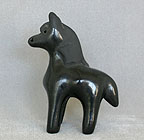 Example of Native American Matte on Black Pottery
Example of Native American Matte on Black Pottery
White Slipped Polychrome. The clay used for this pottery may be any color. The shaped pot is covered with a white clay slip and painted in traditional patterns, animals, birds, flowers, or geometric designs, using mineral based red paint and some variation of wild spinach for black.
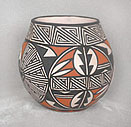 Example of Native American White Slipped Polychrome Pottery
Example of Native American White Slipped Polychrome Pottery
Micaceous Pottery. Traditionally, this unpainted pottery has no slip or painted decoration. Potters use locally gathered clays with flecks of mica in it, then shape, polish and fire the pots in open kilns. Some imitation pottery may have a micaceous slip to give the commercial clay sparkle.
Sgraffito or Etched Pottery. In this style of pottery, the potter carves through the colored slip to reveal the color of the slips or clay underneath. The clays and slips used may be traditional or commercial. Many Navajo potters use the sgraffito technique with commercial clay to create multi-colored pottery etched with bands of complex geometric and symbolic designs.
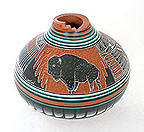 Example of Native American Sgraffito or Etched Pottery
Example of Native American Sgraffito or Etched Pottery
Storytellers, Fetishes and Figurines. These clay figures are usually hand shaped, not molded, and are white slipped clay painted with red and black and white. Based on pre-historic effigy pots and bird shaped pots and canteens, today pueblo potters create a huge variety of traditional and non-traditional figures-everything from Santa Claus to cowboys.
The popular storyteller figurine was created by a Cochiti potter named Helen Cordero in 1964. According to Stephen Trimble, when Cordero was asked to create a figure with children, she remembered her grandfather telling stories to the grandchildren clustered around him, and the storyteller was born.
Horsehair Pottery. It's said that horsehair pottery was discovered by a pueblo potter whose long hair blew against a piece of pottery she was removing from a hot kiln, stuck and carbonized. The result was so interesting that she duplicated it with hair from a horse's tail. Today members of many tribes make horsehair pottery. Sometimes it is etched or decorated with pieces of turquoise, sometimes it may have a design painted over the horsehair.
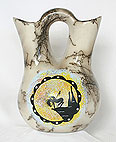 Example of Native American Horsehair Pottery
Example of Native American Horsehair Pottery
What to Look for in Native American Pottery
Because of its popularity, a lot of Native American pottery is made today. Basically, two kinds of Native American pottery are on offer: pottery that is made from naturally occurring clays, cleaned, ground, wedged, and shaped by the potter and usually fired in an open kiln, and; pottery made from commercial clay that is decorated and fired in an open kiln or more often, in a closed commercial kiln. Due to the huge amount of work involved in creating pottery from hand picked clay, the prices on these pieces are much higher. This kind of pottery is a work of art-it speaks to the soul.
Even if you can't afford a completely hand made piece of Native American pottery, there is a lot of beautiful work being done using commercial clay.
Clays. Ask the artist or seller if the piece was made with natural or commercial clays. Natural clays come in many colors. The type of natural clay used may affect the pot's surface. Pottery made from micaceous clay will have a sparkle from mica specks embedded in the clay.
Pots made from Acoma clay may have some surface pitting. Talking with the Clay points out that this situation leaves Acoma potters on the horns of a dilemma. If people will not buy pots made from traditional clay because they have pitting, then their alternative is to use commercial or other clays and paint traditional patterns on them.
Technique. Pottery made from natural clay may be shaped by the slab technique, by paddle and anvil, coiled or molded. Artists are happy to explain what shaping technique was used, as well as whether or not the piece has a slip and how it was burnishing and fired. Non-traditional pottery is often molded or thrown on a potter's wheel.
Paints. Native American potters of the Southwest usually use natural paints made from plants or minerals to decorate their work. However, some potters may add small amounts of commercial color for accent (an example is turquoise paint or slip used to create turquoise jewelry on pottery figurines). If the colors on a piece of pottery are bright and primary, they aren't natural paints.
Firing. Higher temperatures make pottery baked in a closed commercial kiln harder than open-kiln fired pottery. This means that open kiln fired pottery is more fragile than closed kiln fired pottery. Open kilns are subject to hot or cool spots in the combustibles used, as well as the occasional ill-timed breeze. A fire cloud on open kiln fired pottery should not be considered a blemish, but a unique characteristic of the pot.
Signature or Hallmark. Almost all Native American potters put their name or hallmark on their work, and may also note their tribe. It's usually on the bottom or back of the piece.
![]() Shop for Native American Pottery
Shop for Native American Pottery
This information is provided to help you in selecting and evaluating Native American jewelry and crafts.
We are happy to answer questions by email.
Please note that Coyote's Game does not buy or sell used or vintage pottery, nor do we appraise Native American pottery.
Email us at
© 1999-2024 Coyote's Game. Reproduction without permission is prohibited.
